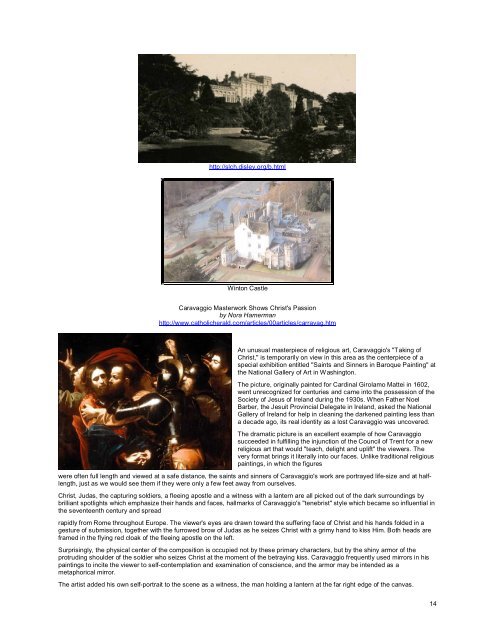Grand Masters of Scotland - Onondaga and Oswego Masonic ...
Grand Masters of Scotland - Onondaga and Oswego Masonic ...
Grand Masters of Scotland - Onondaga and Oswego Masonic ...
Create successful ePaper yourself
Turn your PDF publications into a flip-book with our unique Google optimized e-Paper software.
http://slch.disley.org/b.html<br />
Winton Castle<br />
Caravaggio Masterwork Shows Christ's Passion<br />
by Nora Hamerman<br />
http://www.catholicherald.com/articles/00articles/carravag.htm<br />
An unusual masterpiece <strong>of</strong> religious art, Caravaggio's "Taking <strong>of</strong><br />
Christ," is temporarily on view in this area as the centerpiece <strong>of</strong> a<br />
special exhibition entitled "Saints <strong>and</strong> Sinners in Baroque Painting" at<br />
the National Gallery <strong>of</strong> Art in Washington.<br />
The picture, originally painted for Cardinal Girolamo Mattei in 1602,<br />
went unrecognized for centuries <strong>and</strong> came into the possession <strong>of</strong> the<br />
Society <strong>of</strong> Jesus <strong>of</strong> Irel<strong>and</strong> during the 1930s. When Father Noel<br />
Barber, the Jesuit Provincial Delegate in Irel<strong>and</strong>, asked the National<br />
Gallery <strong>of</strong> Irel<strong>and</strong> for help in cleaning the darkened painting less than<br />
a decade ago, its real identity as a lost Caravaggio was uncovered.<br />
The dramatic picture is an excellent example <strong>of</strong> how Caravaggio<br />
succeeded in fulfilling the injunction <strong>of</strong> the Council <strong>of</strong> Trent for a new<br />
religious art that would "teach, delight <strong>and</strong> uplift" the viewers. The<br />
very format brings it literally into our faces. Unlike traditional religious<br />
paintings, in which the figures<br />
were <strong>of</strong>ten full length <strong>and</strong> viewed at a safe distance, the saints <strong>and</strong> sinners <strong>of</strong> Caravaggio's work are portrayed life-size <strong>and</strong> at halflength,<br />
just as we would see them if they were only a few feet away from ourselves.<br />
Christ, Judas, the capturing soldiers, a fleeing apostle <strong>and</strong> a witness with a lantern are all picked out <strong>of</strong> the dark surroundings by<br />
brilliant spotlights which emphasize their h<strong>and</strong>s <strong>and</strong> faces, hallmarks <strong>of</strong> Caravaggio's "tenebrist" style which became so influential in<br />
the seventeenth century <strong>and</strong> spread<br />
rapidly from Rome throughout Europe. The viewer's eyes are drawn toward the suffering face <strong>of</strong> Christ <strong>and</strong> his h<strong>and</strong>s folded in a<br />
gesture <strong>of</strong> submission, together with the furrowed brow <strong>of</strong> Judas as he seizes Christ with a grimy h<strong>and</strong> to kiss Him. Both heads are<br />
framed in the flying red cloak <strong>of</strong> the fleeing apostle on the left.<br />
Surprisingly, the physical center <strong>of</strong> the composition is occupied not by these primary characters, but by the shiny armor <strong>of</strong> the<br />
protruding shoulder <strong>of</strong> the soldier who seizes Christ at the moment <strong>of</strong> the betraying kiss. Caravaggio frequently used mirrors in his<br />
paintings to incite the viewer to self-contemplation <strong>and</strong> examination <strong>of</strong> conscience, <strong>and</strong> the armor may be intended as a<br />
metaphorical mirror.<br />
The artist added his own self-portrait to the scene as a witness, the man holding a lantern at the far right edge <strong>of</strong> the canvas.<br />
14







![Richard [Nicholls] Harison / Harrison - Onondaga and Oswego ...](https://img.yumpu.com/24950065/1/190x245/richard-nicholls-harison-harrison-onondaga-and-oswego-.jpg?quality=85)

![Richard [Nicholls] Harison / Harrison - Onondaga and Oswego ...](https://img.yumpu.com/24950063/1/190x245/richard-nicholls-harison-harrison-onondaga-and-oswego-.jpg?quality=85)







